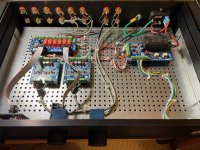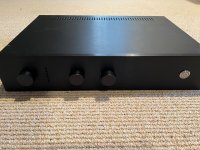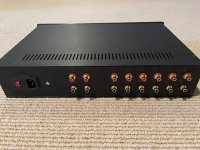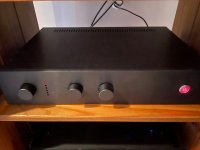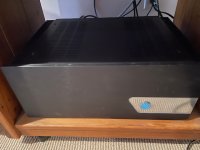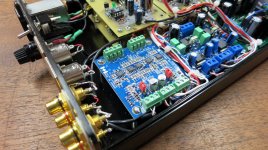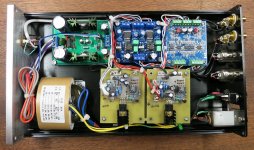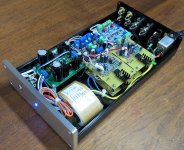Neurochrome Preamp Build
I recently completed my new Neurochrome preamp build (pictures included below). It utilizes five of the Neurochrome sub-assemblies. These include the Input Selector Board, the Input Selector Switch and Volume Control, two Universal Buffer (Unibuf) preamp boards, and the Preamp Power Supply Board. I also utilized the Slimline 2U chassis from the DIY store with the 10mm front panel. The completed preamp is currently wired for three inputs but will accommodate expansion to six down the road. I incorporated the second Unibuf board for a subwoofer. The Unibufs are configured for gain of 2.7. The chassis design was a little challenging using the 10mm front panel, as it had to accommodate mounting for the Selector Switch assembly with the six indicator leds. Unfortunately I didn't provide sufficient recess for the leds to be clearly seen from different angles, and I needed more recess for the mounting nuts for the potentiometer and selector switch. I fixed the issue for the pots, but the led situation will have to wait. I may redesign it down the road. The pictures included show the internal and external views.
Now on to the best part. I am using the preamp with a DIY Audio F6 power amp (picture also included) that I finished up last February. The preamp and the F6 are dead quiet and sound terrific through my old pair of 80’s vintage Magnapanar MGII's and a Polk subwoofer. This setup really does justice to my jazz collection! I am amazed at how clear it sounds and how easy it is to listen to. Definition is very good with vocals, high piano notes, and cymbals being very crisp. I haven't tried the preamp with a more powerful power amp yet and will do so in the near future.
Other thoughts about the build. Selecting the correct gain was a bit of a head scratcher. The F6 power amp has a power supply operating at +/-18VDC, so I wanted to use all of it without over driving it and making it mushy on top. I'm happy with the gain at 2.7, but I'm curious to see how this will work on other power amps. Unfortunately, changing gain requires unsoldering and changing the gain resistors. The Unibuf boards are small with surface mount components all over them. One has to be somewhat skilled and careful. The Preamp Power Supply is a nifty little board. In addition to providing power for the various components in the preamp, it also provides for stand-by functionality and 12V trigger for other components in a hifi setup. I did not wire the 12V trigger but may do so down the road. I did implement this function in the F6 and tested it on some of my commercial hifi stuff. The Neurochrome components are very well designed and work flawlessly together. Also, the documentation provided with the Neurochrome components is excellent, and Tom Christiansen was amazingly responsive when I had questions.
Closing thoughts. This preamp build was not inexpensive, but I'm very pleased with the results. The contrast between building this preamp and building the F6 was quite stark (future vs past). The Neurochrome components are state of the art (almost Lego like) with associated benefits and limitations. The F6 build was much more rudimentary, also providing excellent results but different challenges. Makes me wonder where hobbying is headed down the road.
I recently completed my new Neurochrome preamp build (pictures included below). It utilizes five of the Neurochrome sub-assemblies. These include the Input Selector Board, the Input Selector Switch and Volume Control, two Universal Buffer (Unibuf) preamp boards, and the Preamp Power Supply Board. I also utilized the Slimline 2U chassis from the DIY store with the 10mm front panel. The completed preamp is currently wired for three inputs but will accommodate expansion to six down the road. I incorporated the second Unibuf board for a subwoofer. The Unibufs are configured for gain of 2.7. The chassis design was a little challenging using the 10mm front panel, as it had to accommodate mounting for the Selector Switch assembly with the six indicator leds. Unfortunately I didn't provide sufficient recess for the leds to be clearly seen from different angles, and I needed more recess for the mounting nuts for the potentiometer and selector switch. I fixed the issue for the pots, but the led situation will have to wait. I may redesign it down the road. The pictures included show the internal and external views.
Now on to the best part. I am using the preamp with a DIY Audio F6 power amp (picture also included) that I finished up last February. The preamp and the F6 are dead quiet and sound terrific through my old pair of 80’s vintage Magnapanar MGII's and a Polk subwoofer. This setup really does justice to my jazz collection! I am amazed at how clear it sounds and how easy it is to listen to. Definition is very good with vocals, high piano notes, and cymbals being very crisp. I haven't tried the preamp with a more powerful power amp yet and will do so in the near future.
Other thoughts about the build. Selecting the correct gain was a bit of a head scratcher. The F6 power amp has a power supply operating at +/-18VDC, so I wanted to use all of it without over driving it and making it mushy on top. I'm happy with the gain at 2.7, but I'm curious to see how this will work on other power amps. Unfortunately, changing gain requires unsoldering and changing the gain resistors. The Unibuf boards are small with surface mount components all over them. One has to be somewhat skilled and careful. The Preamp Power Supply is a nifty little board. In addition to providing power for the various components in the preamp, it also provides for stand-by functionality and 12V trigger for other components in a hifi setup. I did not wire the 12V trigger but may do so down the road. I did implement this function in the F6 and tested it on some of my commercial hifi stuff. The Neurochrome components are very well designed and work flawlessly together. Also, the documentation provided with the Neurochrome components is excellent, and Tom Christiansen was amazingly responsive when I had questions.
Closing thoughts. This preamp build was not inexpensive, but I'm very pleased with the results. The contrast between building this preamp and building the F6 was quite stark (future vs past). The Neurochrome components are state of the art (almost Lego like) with associated benefits and limitations. The F6 build was much more rudimentary, also providing excellent results but different challenges. Makes me wonder where hobbying is headed down the road.
Neurochrome Line Stage Build
I decided to build a Neurochrome Line Stage to finish up my office system which has the Modulus 86 at its heart.
I utilized a Neurochrome Universal Buffer as a single ended to balanced converter line stage. This is placed between an unbalanced digital relay attenuator I already had and the Modulus 86. The line stage also contains a generic headphone amp circuit board I purchased off Ebay but stuffed myself...headphone listening is not a priority. Both circuits are driven by Jung Super regulators which are driven by a 317/337 power supply.
The line stage driving the Mod 86 is extremely TRANSPARENT. It is not a colorizing machine but the signal as it is. I must say this thing scavenges the lowest octaves as compared to the preamp I was using before. Dynamics and snap is all there. One day when I have the courage I will need to AB against my Benchmark LA4. I don't know if the Jung Super Regulator is contributing but I am sure it is not hurting either. This is my last build for the office.
Wiring looks a bit cluttered because the PS feedback is taken from the circuit board being driven. Generic aluminum case purchased off AliExpress which have been great for me as I can make compact and very sturdy equipment now.
I decided to build a Neurochrome Line Stage to finish up my office system which has the Modulus 86 at its heart.
I utilized a Neurochrome Universal Buffer as a single ended to balanced converter line stage. This is placed between an unbalanced digital relay attenuator I already had and the Modulus 86. The line stage also contains a generic headphone amp circuit board I purchased off Ebay but stuffed myself...headphone listening is not a priority. Both circuits are driven by Jung Super regulators which are driven by a 317/337 power supply.
The line stage driving the Mod 86 is extremely TRANSPARENT. It is not a colorizing machine but the signal as it is. I must say this thing scavenges the lowest octaves as compared to the preamp I was using before. Dynamics and snap is all there. One day when I have the courage I will need to AB against my Benchmark LA4. I don't know if the Jung Super Regulator is contributing but I am sure it is not hurting either. This is my last build for the office.
Wiring looks a bit cluttered because the PS feedback is taken from the circuit board being driven. Generic aluminum case purchased off AliExpress which have been great for me as I can make compact and very sturdy equipment now.
Attachments
Last edited:
Mikett,
For how compact your creation is I think it is quite neatly done as well! Good work. I like the Jung Super Reg's you have created, that's DIY at heart! If you are ever inspired to replace the 'generic headphone amp circuit board' you purchased off of Ebay for something righteous, I would choose Tom's HP-22...if it fits!
Best,
Anand.
For how compact your creation is I think it is quite neatly done as well! Good work. I like the Jung Super Reg's you have created, that's DIY at heart! If you are ever inspired to replace the 'generic headphone amp circuit board' you purchased off of Ebay for something righteous, I would choose Tom's HP-22...if it fits!
Best,
Anand.
Anand,
This build repurposes some of the boards I have had for a while. The Jung Super Regs are actually vintage 1999. They are from the Jung AD744-811 preamp ( was to be my last) build that was deconstructed when it was replaced by the Benchmark LA4 with the matching AHB2.
At one point I was considering replacing the generic headphone amp with the OPA1622EVM which Tom uses for the HP-22 and this could be driven directly from the Universal buffer. However the holes for the case had already been drilled and again headphone listening was not a priority but as I recall, it could fit. So the option remains down the road....if I am up to it.
This could be a tip for builders using the Neurochrome UB actually , just acquire an OPA1622EVM ($25) to add a headphone output to the preamp.
This build repurposes some of the boards I have had for a while. The Jung Super Regs are actually vintage 1999. They are from the Jung AD744-811 preamp ( was to be my last) build that was deconstructed when it was replaced by the Benchmark LA4 with the matching AHB2.
At one point I was considering replacing the generic headphone amp with the OPA1622EVM which Tom uses for the HP-22 and this could be driven directly from the Universal buffer. However the holes for the case had already been drilled and again headphone listening was not a priority but as I recall, it could fit. So the option remains down the road....if I am up to it.
This could be a tip for builders using the Neurochrome UB actually , just acquire an OPA1622EVM ($25) to add a headphone output to the preamp.
If you are ever inspired to replace the 'generic headphone amp circuit board' you purchased off of Ebay for something righteous, I would choose Tom's HP-22...if it fits!
The HP-22 is tiny. It'll fit.
Nice and compact build, though.
Tom
This could be a tip for builders using the Neurochrome UB actually , just acquire an OPA1622EVM ($25) to add a headphone output to the preamp.
Yep! The TI EVM has balanced inputs with a fairly low input impedance (1 kΩ as I recall). Just add the Universal Buffer and a volume control and you're golden.
Tom
Hi Tom,
pinnocchio said:
When sandwiching Universal Buffer - Input Selector - Volume Control - Universal Buffer, what would be the ideal potentiometer impedance (10K, 20K, 25K, etc)? I'm guessing the lower possible the better, right?
Lower is better. I'd use a 5 kΩ if you can find one. Otherwise a 10 kΩ one.
Tom
I was thinking to replace 10kΩ Alps pot with Khozmo 64 steps attenuator.
Tom, would you recommend to use 5 kΩ one or should I stay with 10kΩ ?
Which an attenuators might work better with your preamp shunt or ladder one ?
Any other suggestions are welcome.
All the best,
Stefan
I'd use 5 kΩ if your source can drive it. If in doubt, go with 10 kΩ.
If going with a Khozmo attenuator, just stick with the 'default' Vishay resistors. They're excellent metal film types.
I doubt there's any difference between the shunt type and the ladder type, but that's probably a better question for Khozmo. I'd ask about the minimum input impedance and maximum output impedance for the two types.
Tom
If going with a Khozmo attenuator, just stick with the 'default' Vishay resistors. They're excellent metal film types.
I doubt there's any difference between the shunt type and the ladder type, but that's probably a better question for Khozmo. I'd ask about the minimum input impedance and maximum output impedance for the two types.
Tom
For starters, purchase an Audio Precision APx 555. I think they start at USD $28K.Just wondering, not questioning these at all as rather cool, but how does one measure this kind of performance? I mean, test equipment needs to be at least an order of magnitude better and that is getting hard to fathom. I mean that is like -160 dB!
And yes, Tom has one. Precision circuit design requires precision lab equipment as long as the right fella is at the helm ;-)
Best,
Anand.
Thank you Tom.I'd use 5 kΩ if your source can drive it. If in doubt, go with 10 kΩ.
If going with a Khozmo attenuator, just stick with the 'default' Vishay resistors. They're excellent metal film types.
I doubt there's any difference between the shunt type and the ladder type, but that's probably a better question for Khozmo. I'd ask about the minimum input impedance and maximum output impedance for the two types.
Tom
Good idea, I will ask Khozmo.
Specs of my sources are as follow :
1.
4.10 V rms – balanced outputs
110 ohms – balanced outputs (55 per phase)
I could not find recommended load for this one.
2.
Output level (0dB) 2.2Vrms
Output impedance 50Ω
Minimum recommended load 5kΩ
Is anyone having experience of AVC or TVC with Neurochrome preamp ?
Stefan
Last edited:
Just my pointFor starters, purchase an Audio Precision APx 555. I think they start at USD $28K.
And yes, Tom has one. Precision circuit design requires precision lab equipment as long as the right fella is at the helm ;-)
Best,
Anand.
"Residual THD+N (22 kHz BW)
–117 dB + 1.0 µV
Typically <–120 dB (1 kHz, 2.0 V)"
This buffer specification is orders of magnitude better that the test equipment. I can simulate at those levels, but I do not know how to measure them.
Please, I am not being critical, I am curious as this kind of performance was virtually impossible when I was a lab rat.
Using external ultra-low distortion oscillators (like Victor's) and notch filters such low THD can be measured reliably even without the need for terribly expensive analysers like the APx 555. I have attached a few measurements I did when I tested the buffer some time ago. From what I measure Tom's claims seems valid.


In my case a RTX6001 Audio Analyzer, but I have seen it done using simple sound cards. Software is REW.
The critical point is not really the acquisition unit, but finding an oscillator which is an order of magnitude better than what you want to measure. The rest is fairly easy using a notch filter (and possibly a LNA).
Victors fixed oscillators are cheap and possibly good for below -150 dB THD. There is a long thread about about these oscillators here.
The critical point is not really the acquisition unit, but finding an oscillator which is an order of magnitude better than what you want to measure. The rest is fairly easy using a notch filter (and possibly a LNA).
Victors fixed oscillators are cheap and possibly good for below -150 dB THD. There is a long thread about about these oscillators here.
- Home
- Vendor's Bazaar
- Universal Buffer achieving -140 dBc (0.00001 %) THD
